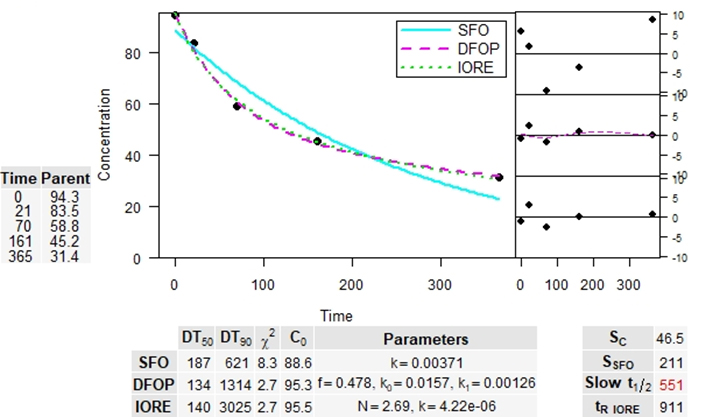
A DFOP-based PRZM model to predict non-first order degradation and subsurface transport in soil and groundwater
Chemicals applied to a field have the potential for degradation to be underestimated when modeling soil residues and groundwater concentrations. Many soil metabolism and other environmental fate studies have observed non-first order degradation often in a biphasic pattern with fast initial decline followed by a noticeably slower phase, which deviates from the classical simple first-order SFO kinetics. SFO kinetics used in modeling when the chemical observes a biphasic pattern tends to over-predict groundwater concentrations, which would increase dietary exposure from drinking water. To overcome this SFO challenge, Waterborne applies an updated version of PRZM (winPRZM) that can better predict concentrations in soil and groundwater and match field study results.
Although widely recognized, biphasic degradation has never been directly incorporated into regulatory models. Instead, most regulatory models require an SFO curve fit preferentially to the slow portion of the decline data while largely ignoring the fast initial phase. As a result, modeling errors in the predicted exposure levels in surface water and groundwater can be artificially elevated. The EU PRZM model (winPRZM) was updated with code developed by Waterborne and Syngenta to handle Double First-Order in Parallel (DFOP) kinetics.
The model directly incorporates the kinetics of DFOP to account for the complete biphasic decline profile with the option to account for the temperature and soil moisture effects. Sensitivity analysis of winPRZM shows that the model converges to the same results of the original PRZM model when the kinetics fit is SFO. When the kinetics shows DFOP characteristics, winPRZM can

Calculated Biphasic Degradation Rates:
- DFOP equation
Ct = C0g-k1t + C0(1 – g)-k2t- g is the fraction of the C0 as being Fraction 1
- k1 = rate constant for Fraction 1 in 1/days
- k2 = rate constant for Fraction 2 in 1/days
- NAFTA kinetics calculation (PestDF) by available laboratory soil metabolism studies
- DFOP fits provided the fraction of the initial chemical that degrades at the fast rate represent biphasic degradation in the soil better. Using DFOP, winPRZM can predict soil and pore water residues.
Example of a kinetics calculation output:
 Adding the DFOP code to winPRZM was straight forward using existing functionality. The new code allows for three DFOP options: DFOP parent only (DFOP1), DFOP parent to non-DFOP metabolite (DFOP2), and non-DFOP parent to DFOP metabolite (DFOP3). First, a DFOP flag was added to the winPRZM execution supervisor file to specify which of the three options is being simulated. DFOP1 and DFOP2 distribute the total application rate between hypothetical “chemical 1” and “chemical 2”. Next, when non-linear sorption (Kf) is on, an internal calculation adds the respective soil concentrations at the end of the time step to determine the next day Kf value. DFOP3 utilizes the degradation yield fractions to transfer parent to the DFOP metabolite. Kf sorption is then handled similarly to parent. Finally, additional output files for the annual summary files were created along with DFOP specific time series variables.
Adding the DFOP code to winPRZM was straight forward using existing functionality. The new code allows for three DFOP options: DFOP parent only (DFOP1), DFOP parent to non-DFOP metabolite (DFOP2), and non-DFOP parent to DFOP metabolite (DFOP3). First, a DFOP flag was added to the winPRZM execution supervisor file to specify which of the three options is being simulated. DFOP1 and DFOP2 distribute the total application rate between hypothetical “chemical 1” and “chemical 2”. Next, when non-linear sorption (Kf) is on, an internal calculation adds the respective soil concentrations at the end of the time step to determine the next day Kf value. DFOP3 utilizes the degradation yield fractions to transfer parent to the DFOP metabolite. Kf sorption is then handled similarly to parent. Finally, additional output files for the annual summary files were created along with DFOP specific time series variables.
Simulation results compared to field studies were presented in a poster at the 2022 Pesticide Behavior in Soils, Water and Air conference in York, UK. The overall model performance suggests winPRZM can be used as a predictive tool to handle biphasic degradation behavior frequently observed in pesticide field studies.

Waterborne Environmental, Inc. Hired to Create Online Dashboard That Tracks Nutrient Loss Across the State of Missouri
READ MORE

Swimming with Bacteria: Water Quality Concerns at the 2024 Paris Olympics
READ MORE

The Right Tool – Multidimensional Models
READ MORE



